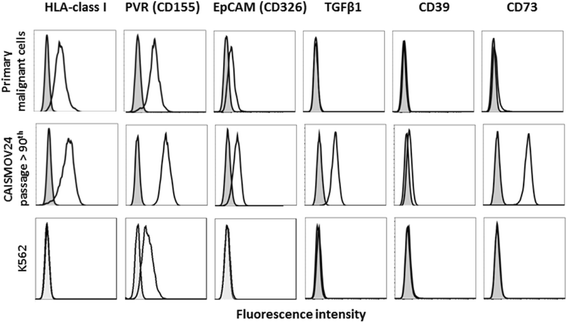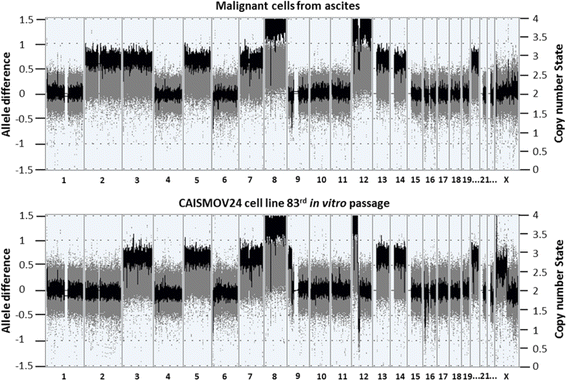CAISMOV24, a new human low-grade serous ovarian carcinoma cell line
- PMID: 29132324
- PMCID: PMC5683553
- DOI: 10.1186/s12885-017-3716-4
CAISMOV24, a new human low-grade serous ovarian carcinoma cell line
Abstract
Background: The spontaneous immortalization of primary malignant cells is frequently assigned to their genetic instability during in vitro culturing. In this study, the new epithelial ovarian cancer cell line CAISMOV24 was described and compared with its original low-grade serous ovarian carcinoma.
Methods: The in vitro culture was established with cells isolated from ascites of a 60-year-old female patient with recurrent ovarian cancer. The CAISMOV24 line was assessed for cell growth, production of soluble biomarkers, expression of surface molecules and screened for typical mutations found in serous ovarian carcinoma. Additionally, comparative genomic hybridization was employed to compare genomic alterations between the CAISMOV24 cell line and its primary malignant cells.
Results: CAISMOV24 has been in continuous culture for more than 30 months and more than 100 in vitro passages. The cell surface molecules EpCAM, PVR and CD73 are overexpressed on CAISMOV24 cells compared to the primary malignant cells. CAISMOV24 continues to produce CA125 and HE4 in vitro. Although the cell line had developed alongside the accumulation of genomic alterations (28 CNV in primary cells and 37 CNV in CAISMOV24), most of them were related to CNVs already present in primary malignant cells. CAISMOV24 cell line harbored KRAS mutation with wild type TP53, therefore it is characterized as low-grade serous carcinoma.
Conclusion: Our results corroborate with the idea that genomic alterations, depicted by CNVs, can be used for subtyping epithelial ovarian carcinomas. Additionally, CAISMOV24 cell line was characterized as a low-grade serous ovarian carcinoma, which still resembles its primary malignant cells.
Keywords: Ascites; Cell culture; Comparative genomic hybridization; KRAS.
Conflict of interest statement
Authors’ information
JAY and SFD are Fellowship from the Brazilian National Counsel of Technological and Scientific Development.
Ethics approval and consent to participate
The study was approved by the Research Ethics Committee of University of Campinas (27 September 2011, 897/2011) and was registered on the Brazilian National Health Council (CAAE: 0807.0.146.000–11). Patient provided written informed consent for the use of her blood and ascites samples, and her data.
Consent for publication
A written informed consent for publication of patient’s information was provided by the patient’s next of kin.
Competing interests
Sophie Françoise Derchain is an editorial board member of BMC Cancer. The authors declare that they have no competing interests.
Publisher’s Note
Springer Nature remains neutral with regard to jurisdictional claims in published maps and institutional affiliations.
Figures





Similar articles
-
Genomic classification of serous ovarian cancer with adjacent borderline differentiates RAS pathway and TP53-mutant tumors and identifies NRAS as an oncogenic driver.Clin Cancer Res. 2014 Dec 15;20(24):6618-30. doi: 10.1158/1078-0432.CCR-14-1292. Epub 2014 Oct 14. Clin Cancer Res. 2014. PMID: 25316818
-
Establishment and Characterization of the Novel High-Grade Serous Ovarian Cancer Cell Line OVPA8.Int J Mol Sci. 2018 Jul 17;19(7):2080. doi: 10.3390/ijms19072080. Int J Mol Sci. 2018. PMID: 30018258 Free PMC article.
-
Characterization of active mitogen-activated protein kinase in ovarian serous carcinomas.Clin Cancer Res. 2004 Oct 1;10(19):6432-6. doi: 10.1158/1078-0432.CCR-04-0893. Clin Cancer Res. 2004. PMID: 15475429
-
Low Grade Serous Ovarian Carcinoma: from the molecular characterization to the best therapeutic strategy.Cancer Treat Rev. 2015 Feb;41(2):136-43. doi: 10.1016/j.ctrv.2014.12.003. Epub 2014 Dec 23. Cancer Treat Rev. 2015. PMID: 25573350 Review.
-
HMGA2 and high-grade serous ovarian carcinoma.J Mol Med (Berl). 2013 Oct;91(10):1155-65. doi: 10.1007/s00109-013-1055-8. Epub 2013 May 19. J Mol Med (Berl). 2013. PMID: 23686260 Review.
Cited by
-
Ovarian Cancer-Associated Ascites Have High Proportions of Cytokine-Responsive CD56bright NK Cells.Cells. 2021 Jul 6;10(7):1702. doi: 10.3390/cells10071702. Cells. 2021. PMID: 34359872 Free PMC article.
-
Patient-derived tumor models are attractive tools to repurpose drugs for ovarian cancer treatment: pre-clinical updates.Oncotarget. 2022 Mar 24;13:553-575. doi: 10.18632/oncotarget.28220. eCollection 2022. Oncotarget. 2022. PMID: 35359749 Free PMC article. Review.
-
Three-Dimensional Cell Culture Based on Magnetic Fields to Assemble Low-Grade Ovarian Carcinoma Cell Aggregates Containing Lymphocytes.Cells. 2020 Mar 6;9(3):635. doi: 10.3390/cells9030635. Cells. 2020. PMID: 32155738 Free PMC article.
-
Establishment and characterization of a cell line and patient-derived xenograft (PDX) from peritoneal metastasis of low-grade serous ovarian carcinoma.Sci Rep. 2020 Apr 21;10(1):6688. doi: 10.1038/s41598-020-63738-6. Sci Rep. 2020. PMID: 32317693 Free PMC article.
-
Rare Epithelial Ovarian Cancers: Low Grade Serous and Mucinous Carcinomas.Cold Spring Harb Perspect Med. 2023 Sep 1;13(9):a038190. doi: 10.1101/cshperspect.a038190. Cold Spring Harb Perspect Med. 2023. PMID: 37277207 Free PMC article. Review.
References
-
- Vargas AN. Natural history of ovarian cancer. Cancer Science &Therapy. 2014;6:247–252.
MeSH terms
Substances
Grants and funding
LinkOut - more resources
Full Text Sources
Other Literature Sources
Medical
Research Materials
Miscellaneous

